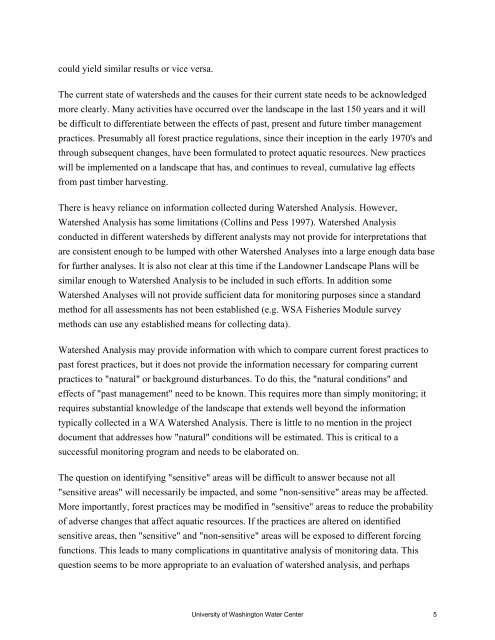Review of the TFW Monitoring Program.pdf
Review of the TFW Monitoring Program.pdf
Review of the TFW Monitoring Program.pdf
Create successful ePaper yourself
Turn your PDF publications into a flip-book with our unique Google optimized e-Paper software.
could yield similar results or vice versa.<br />
The current state <strong>of</strong> watersheds and <strong>the</strong> causes for <strong>the</strong>ir current state needs to be acknowledged<br />
more clearly. Many activities have occurred over <strong>the</strong> landscape in <strong>the</strong> last 150 years and it will<br />
be difficult to differentiate between <strong>the</strong> effects <strong>of</strong> past, present and future timber management<br />
practices. Presumably all forest practice regulations, since <strong>the</strong>ir inception in <strong>the</strong> early 1970's and<br />
through subsequent changes, have been formulated to protect aquatic resources. New practices<br />
will be implemented on a landscape that has, and continues to reveal, cumulative lag effects<br />
from past timber harvesting.<br />
There is heavy reliance on information collected during Watershed Analysis. However,<br />
Watershed Analysis has some limitations (Collins and Pess 1997). Watershed Analysis<br />
conducted in different watersheds by different analysts may not provide for interpretations that<br />
are consistent enough to be lumped with o<strong>the</strong>r Watershed Analyses into a large enough data base<br />
for fur<strong>the</strong>r analyses. It is also not clear at this time if <strong>the</strong> Landowner Landscape Plans will be<br />
similar enough to Watershed Analysis to be included in such efforts. In addition some<br />
Watershed Analyses will not provide sufficient data for monitoring purposes since a standard<br />
method for all assessments has not been established (e.g. WSA Fisheries Module survey<br />
methods can use any established means for collecting data).<br />
Watershed Analysis may provide information with which to compare current forest practices to<br />
past forest practices, but it does not provide <strong>the</strong> information necessary for comparing current<br />
practices to "natural" or background disturbances. To do this, <strong>the</strong> "natural conditions" and<br />
effects <strong>of</strong> "past management" need to be known. This requires more than simply monitoring; it<br />
requires substantial knowledge <strong>of</strong> <strong>the</strong> landscape that extends well beyond <strong>the</strong> information<br />
typically collected in a WA Watershed Analysis. There is little to no mention in <strong>the</strong> project<br />
document that addresses how "natural" conditions will be estimated. This is critical to a<br />
successful monitoring program and needs to be elaborated on.<br />
The question on identifying "sensitive" areas will be difficult to answer because not all<br />
"sensitive areas" will necessarily be impacted, and some "non-sensitive" areas may be affected.<br />
More importantly, forest practices may be modified in "sensitive" areas to reduce <strong>the</strong> probability<br />
<strong>of</strong> adverse changes that affect aquatic resources. If <strong>the</strong> practices are altered on identified<br />
sensitive areas, <strong>the</strong>n "sensitive" and "non-sensitive" areas will be exposed to different forcing<br />
functions. This leads to many complications in quantitative analysis <strong>of</strong> monitoring data. This<br />
question seems to be more appropriate to an evaluation <strong>of</strong> watershed analysis, and perhaps<br />
University <strong>of</strong> Washington Water Center 5
















